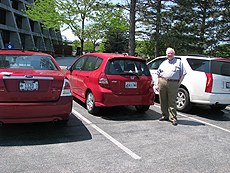Lessons from license plates
 |
Fermilab scientist John Cooper has collected two years' worth of data on the states represented in the Wilson Hall parking lot's license plates.
|
At Fermilab, the close parking spaces go to those who arrive early. John Cooper is not an early riser, so on the long walks from his car every morning, he does mental exercises in order to prepare for his workday.
Beginning in early 2012, the NOvA project manager began memorizing the out-of-state license plates he saw each morning. Cooper believes that the results from the two-year exercise show that Fermilab truly is a national place.
"I was seeing a lot of out-of-state license plates and I thought there were more than before," Cooper said. "It reminded me of when I was a kid. My parents and I counted license plates from different states when we took road trips."
Once he got to his desk each day, Cooper logged into a spreadsheet the state plates that he had seen. He had a mechanism for remembering the plates, such as CC for two California plates, and weeded out rental cars by looking for their bar codes or stickers.
"I suspect most of the cars are those of students and postdocs stationed here at Fermilab for long enough times to make the drive worth it. In that sense, we have visual evidence that we serve the entire nation in training younger people in science," Cooper said.
During the two years of counting, Cooper recorded plates from 47 of the 50 states and from the District of Columbia. He spoke to a few of the out-of-state drivers, who were at the lab to work on experiments or as part of scientific or computing collaborations.
While the exercise wasn't scientific, Cooper said he did find the data interesting.
"It means we are a really national laboratory," he said. "We have a world-class laboratory in Illinois and it serves the entire country."
Barb Brooks, deputy head of WDRS, echoed Cooper's assessment.
"Members of Fermilab's community come from all over," she said. "At any given point in time you might be sharing office space with someone from Washington state and having lunch with someone from Washington, D.C. There aren't many places in the world, let alone in the United States, where you can do the kind of research we do here. It makes sense that our population is so geographically diverse."
—Rhianna Wisniewski
|